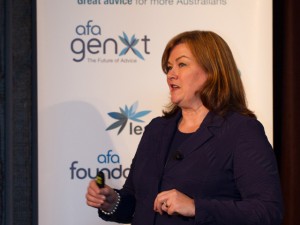Riskinfo’s Peter Sobels spoke to MDRT committee member, Ryan Pinney, at this year’s Annual Meeting in Toronto. Pinney shared some critically important observations about how the life insurance conversation between adviser and client is evolving in the US, and what opportunities this may create for risk-focused advisers everywhere…
Ryan Pinney began the conversation by considering the demise of the tied agency system in the United States and the flow-on effects stemming from this trend. “In many countries you still see the career agency systems where you work for one company and one company only. In the US, that system started to disappear in the 70s and 80s, and by the early to mid-90s, in many instances, it was largely gone.”
Pinney, VP, Sales & Marketing at Pinney Insurance Center, says there remain only a handful of companies that still recruit to the ‘captive’ agent model. “This is a very important trend and it has a double-edged effect to it. [Under an independent agency system] you have more people able to offer a wider range of product solutions – a greater variety, and maybe better able to serve the customer. But because you don’t have the training grounds you used to have in the career agency systems, fewer young advisers are coming into the industry.”
He says the down-side of an advice sector that is trending to less captive and more multi-agent systems is that less agents are experiencing the soft skills traditionally taught through the career agency structure. “Where this manifests itself the most in the US is in a lot of younger agents who are turning to technology solutions to be able to get their messages out and to interact with their natural customer bases.” But Pinney says possessing technical skills doesn’t necessarily equate to being able to ‘market’, “…and technical skills definitely don’t equate to being able to sell”.
“So, the question becomes: how do you take someone with technical skills and teach them the soft skills needed, such as marketing, customer service and selling skills? How do you give them those skills? In the old agency system, that was usually taught by someone who had the experience and mentoring capability. But today’s younger independent agents don’t have that access.”
The issue of a general down-turn in the ability for new advisers in the life insurance industry to access soft skills training is complicated by changing trends in how people communicate with each other and how advisers are looking to add value to their client relationships.
Creating new consumer solutions
But Pinney and his business have embarked on a journey to address both these challenges. According to Pinney, the answer lies in marrying advice, technology and new styles of life insurance products.
“Because of the massive amount of online information now available to the public, the consumer already knows what they’re looking for or trying to accomplish. So how do you arm today’s adviser to have that kind of conversation with the client who has already settled with what they think they want or need?”
because you don’t have the training grounds you used to have in the career agency systems, fewer young advisers are coming into the industry
With the growth of the Internet over the last ten years, and over the last four to five years in particular, Pinney’s firm has focused on how it can help its team of advisers become better marketers and learn better sales skills within this changing consumer environment. “We’ve taken our learnings from member associations like MDRT and NAIFA. We’ve taken the best ideas and distilled them down into salient points for our advisers to use. This has worked well, and the brokering side of our business has been doing well because of this changed focus on skills training.
“People are coming back full circle because they realise that kind of training and soft skills capability has been lost, and they’re coming back again. This is of paramount importance for all agencies out there, whether it’s brokerage firms in the US, or an independent agency out of Australia, or career agencies in Singapore – they all need the marketing skills to pass to their advisers to help them do their jobs. Those tools are there, not to replace the sales person, but to augment them.”
“Our direct sales are also growing,” says Pinney, often via advisers who conduct ‘direct’ insurance selling. “We sold 20,000 direct insurance policies last year and we’re seeing that part of the market grow. We have advisers that work with our firm in a brokerage capacity, several of whom are generating a couple of hundred policy sales each month for themselves. That means they’re selling a thousand or two thousand policies each year. And they are just individual brokers using the same direct marketing tools. So, those guys have become marketers, not just ‘sellers’ in the traditional sense. It’s just a change in mind set.”
Pinney says his firm’s team of advisers who undertake direct sales utilise full, ‘retail’ life insurance products as well as direct insurance products. “Over the last couple of years we’ve gone from where 90% – 95% of our business was fully underwritten, ‘traditional’ insurance, to today where that number is now probably more like 60%. And we average between 35% – 40% of our business that is ‘simplified underwriting’ [meaning no medical examinations are required].
“But there are still medical questions and several databases that are checked, such as the US Medical Information Bureau or prescription checks, as well as motor vehicle records. So there’s still underwriting, but its automated and virtual.”
Developing a hybrid life insurance product
One of the great innovations being explored by Pinney’s firm is the development of a new, hybrid life insurance product, inspired by a gap he and his colleagues have identified in the market, positioning it between a fully-underwritten retail product and a minimal-to-nil- underwritten direct insurance contract.
“Because of the volumes we produce we get taken seriously by insurance companies. And if we get this right, then it can be a game-changer for us because we’re going to have a product that meets the needs of what we see an under-served market – the mom and pop middle America.”
Pinney says this hybrid product has been designed for the family that earns around US$50,000 to $60,000 annual income, “… not necessarily living pay check to pay check but being very frugal with their funds.” Pinney believes this huge sector of American society has been under-served because the client in this segment may typically pay an annual insurance premium of around US$800 – $1,000. “It can be really expensive to work with that kind of client if you’re a ‘traditional’ broker and if you have to drive across town to meet with the client, have multiple meetings and do all the paperwork and invest the time it takes to do that. And by the time you add up your costs that’s probably at least US$500 – $600 of your time.” Given the lack of financial attraction to that kind of client business, Pinney reasons this middle-American family client has become significantly under-served.
there’s still underwriting, but its automated and virtual
“But we think that with the right product and the right marketing, we can ‘attack’ that market place and deliver a good service to those clients and do a better job of helping people who need insurance the most.”
The only way Pinney sees this proposition working “… is if we simplify and automate the process and then bring it into a more virtual environment.”
Pinney points out that music is mostly purchased today by downloading the song to a mobile phone for 99 cents. “A lot of things we do in life have moved to that kind of process,” he says, “… press a button and ship it to me and it’s all done.
“I believe we can deliver life insurance in a very similar capacity, but still provide all the information and background and all the paper that’s needed along the way. But you have to make sure you set the client expectation on the front end: ‘Here’s what we’re going to do. Here are the steps we’re going to help you go through along the way.’ And that comes back to soft skills – that’s informing the client and providing the ‘salesmanship’ that’s needed. I don’t necessarily think that has to be done face-to-face. It can be done virtually.”
Pinney referred to recent research that supported his drive to create and deliver virtual life insurance advice systems. At least half the survey respondents said they would be willing to buy life insurance online “… and about a third said that they ONLY want to buy online.”
Combining traditional services with new systems
Within the Pinney Insurance Center model, the client, although served remotely, will still have an adviser to represent their interests at claim time. “Direct insurance, in my mind, doesn’t mean the client is abandoned. If you’re buying direct from an insurance company and you have no advocate, I agree with the argument. We’re using that same direct selling process, but we’re doing it with a qualified adviser. We’re positioning ourselves in the middle, facilitating the process and facilitating the service. And at the end of the day, we’re responsible for service at time of claim [Pinney does not charge a fee at claim time], as well as for change of address, change of bank account; they don’t go to the insurer.”
Almost exclusively, the client finds Pinney Insurance, rather than the other way around. “We do some proactive marketing but mostly the client finds us through Internet search engines. We’ve tried to optimise our website for those key insurance words. But that’s just the beginning of the process.
“Sales and marketing has seen a big shift in recent years. We’ve used all the knowledge we’ve gained over time, and in the last five years we’ve changed our website several times to keep up to date and answer the question: What is the consumer here to do?
“They want information and to be educated and once they’re educated, then they want pricing. We’ve changed our website to engage with the client in the early stages of the process rather than only at the later stage when pricing their options, and have built nurturing campaigns to assist them through the process.”
Pinney believes that “… if you’re sincere about what you do, the client will know it and they will follow your advice.” He also strongly advocates continuous learning: “You can’t stop learning, and you can’t stop changing. You have to stay current.”
Pinney is proud of the services that he and his colleagues deliver, and are seeking to deliver in future. “People hear that you’re in insurance sales and I say, yes, I sell insurance. But that’s a by-product of what I do. What I really do is protect families. That’s the most noble profession in the world, in my opinion.”

Ryan J. Pinney is a five-year MDRT member with five Top of the Table qualifications. He is recognised for using innovative technologies to drive insurance sales, streamline the application process and speed up underwriting. Ryan leverages his experience in social media and online marketing to help agents and agencies create their online presence and profit from it.
















